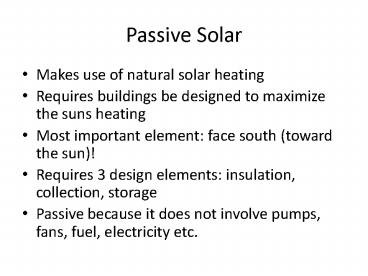Passive Solar - PowerPoint PPT Presentation
Title:
Passive Solar
Description:
Passive Solar Makes use of natural solar heating Requires buildings be designed to maximize the suns heating Most important element: face south (toward the sun)! – PowerPoint PPT presentation
Number of Views:206
Avg rating:3.0/5.0
Title: Passive Solar
1
Passive Solar
- Makes use of natural solar heating
- Requires buildings be designed to maximize the
suns heating - Most important element face south (toward the
sun)! - Requires 3 design elements insulation,
collection, storage - Passive because it does not involve pumps, fans,
fuel, electricity etc.
2
Insulation
- Keep the heat in!
- Walls, floors, ceilings must make use of
materials that help hold in the heat. - Doors and windows must also be designed to
maximize heat retention in the building - Most modern buildings ignore these ideas
3
Collection
- Need a way to collect the suns energy
- One way is large windows on the south face of the
building - Another way is a passive solar collector on the
south wall - In the collector, the heated air rises and flows
into the structure, while the cool air from
inside sinks and flows back into the collector.
No need for fans, this air flow sets itself up
naturally
4
Storage
- Need a thermal mass inside the house
- Thermal mass-any material that can absorb solar
energy then cool down later giving its energy
back to its surroundings. - Example Why is it always warmer in cities than
in the country in the summer, especially at
night? - Buildings and roads act as a thermal mass,
heating up during the day and releasing that heat
at night - In our building the material has to hold enough
heat to keep the temperature constant at night or
over a cloudy day(s).
5
Storage
- The heat stored in the thermal mass is not much
greater than the usual temperature of the
structure, thus a lot of it is needed. - Water is an excellent thermal mass. Tanks of
water could be stored just inside the windows,
but thats not very aesthetic. Another way to use
water is a roof pond (yes a pond on your roof!)
or green roof (yes your garden on your roof). - Example-Since Chicago installed a 20,000 square
foot "green roof" atop City Hall five years
ago(2006 report), the city has saved about
25,000 in energy costs. - Trombe Wall A massive concrete
- wall on the south side of the structure,
- with a space between it and the windows.
- The concrete wall acts as the thermal mass.
- Not only does the wall heat the air in the
- space and convection sets up a natural flow
- to warm the room on the other side, but the
- concrete itself will radiate into the room.
6
Chicago City Hall green roof
7
Storage
- Direct Gain method
- South facing windows with thermal mass in the
floor and opposite wall to regulate and store
heat.
8
Potential
- Based on sun angle, this figure shows the
potential for passive solar use across the US
9
Solar Electric Power generation
- Two types
- Thermal -use suns ability to heat (usually
water) to create electricity - Photovoltaic devices- a device which directly
converts the Suns energy to electricity
10
Solar Thermal
- Obvious idea would be to use sunlight to boil
water and provide steam to drive a turbine - But what happens when you place a container of
water in the sun-it typically does not boil! - Need to concentrate or focus the suns energy to
achieve this goal - How do we focus sunlight?
11
Basic properties of light
- To answer this question, lets look at some basic
properties of light in the wave description of
light. - Refraction-light is bent at the interface between
two media. - Snells law relates the angle
- of incidence and the index
- of refraction of medium 1 to
- the angle of refraction and
- index of refraction of medium
- 2.
12
Focusing light
- If the interface is flat, the light is not
focused. - Example-pencil in a glass of water
- If it is curved in the correct fashion, i.e. the
surface of a convex lens, the light can be
brought to a focus
convex
concave
13
Fresnel Lens
- For the most part, lens are very heavy, suffer
from reflection at the surfaces, and are
expensive to construct to the sizes needed to
achieve the desired heating. - There is one type of lens, a Fresnel lens that
can be inexpensively constructed from plastic
14
Fresnel Lens
- Seen in lighthouses-used to form a concentrated
beam of light.

